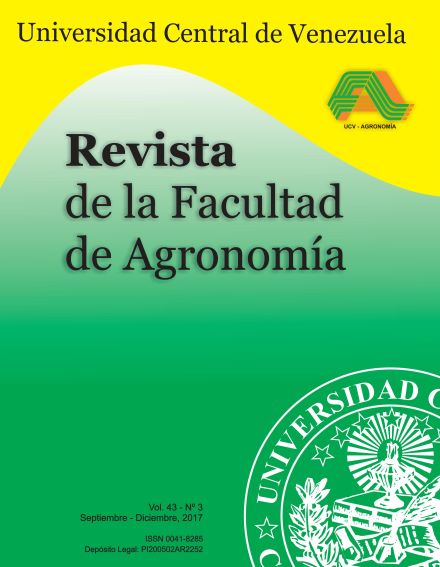Aislamiento y caracterización de bacterias antagonistas y sus metabolitos para el control de Acidovorax avenae subsp. avenae en el cultivo de maíz (Zea mays L.)
Palabras clave:
Control bacterial, Pseudomonas fluorescentes, Bacillus sp, Pantoea, Bacterial controlResumen
Esta investigación tuvo como objetivo buscar alternativas para el manejo de la “quemazón de los cereales”, producida por Acidovorax avenae subsp. avenae, con bacterias obtenidas a partir de muestras de suelo, raíces y hojas, colectadas en plantaciones de maíz, ubicadas en El Asentamiento Campesino Mucura II del municipio Zamora, estado Aragua. De 20 muestras procesadas, fueron seleccionadas 28 colonias, tomando como criterio la capacidad de crecimiento e inhibición de otras colonias en el medio. Para la confrontación in vitro con A. avenae subsp. avenae se utilizaron los medios de cultivo agar nutritivo (AN) y B de King (BK). Para obtener los metabolitos bacterianos, se utilizaron tres aislamientos, tres medios líquidos y dos tiempos de incubación. Las pruebas de eficacia de los metabolitos obtenidos se realizaron en los medios AN y BK. Los aislamientos fueron caracterizados por pruebas culturales, morfológicas, fisiológicas y bioquímicas. Solo 10 aislamientos identificados como S12M, R10M, H2.1M, S10M, S3M, R3M, H1M, H2M, S1.1M, y H1.2M, resultaron con capacidad antagonista a A. avenae subsp. avenae. El mejor medio y tiempo de incubación para la extracción de los metabolitos fue BK y 24 horas. Por las características fenotípicas, los aislamientos S1.1M, H1M, S10M, H1.2M, H2.1M y R10M, fueron ubicados en el género Pseudomonas del grupo fluorescente, S3M y S12M en Bacillus y H2M en Pantoea pero R3M no pudo ser identificado. Las bacterias de los géneros Pseudomonas y Bacillus fueron los más eficaces como antagonistas.
Isolation and characterization of antagonistic bacteria and their metabolites for controlling the Acidovorax avenae subsp. avenae in maize (Zea mays L.)
ABSTRACT
This research was conducted to look for alternatives for the management of the “burning of cereals”, produced by Acidovorax avenae subsp. avenae. The bacteria was obtained from soil, root and leaves samples, collected in corn plantations located in the Múcura II Peasant Settlement, Zamora municipality, Aragua state. Twenty samples were processed, twenty eithg colonies were selected, taking the growth and inhibition capacity of other colonies in the media a criteria. For the in vitro confrontation with A. avenae subsp. avenae culture media nutrient agar (AN) and B of King (BK) were used. Three isolates, three liquids media and two incubation times were used to obtain bacterial metabolites. The effectiveness of the obtained metabolites tests were performed in the AN and BK media. The isolates were characterized by cultural, morphological, physiological, and biochemical tests. Only 10 isolates identified as S12M, R10M, H2.1M, S10M, S3M, R3M, H1M, H2M, S1.1M, and H1.2M, were antagonistic ability to A. avenae subsp. avenae. The best media and incubation time for the extraction of metabolites was BK and 24 hours. By phenotypic characteristics, the isolates S1.1M, H1M, S10M, H1.2M, H2.1M and R10M, were placed in the genus Pseudomonas fluorescent group, S3M and S12M in Bacillus and H2M in Pantoea but R3M could not be identified. The bacteria of the genera Pseudomonas and Bacillus were most effective as antagonists.





